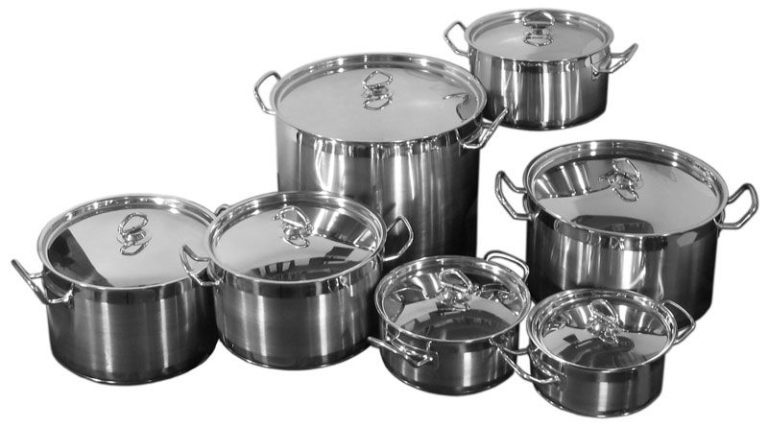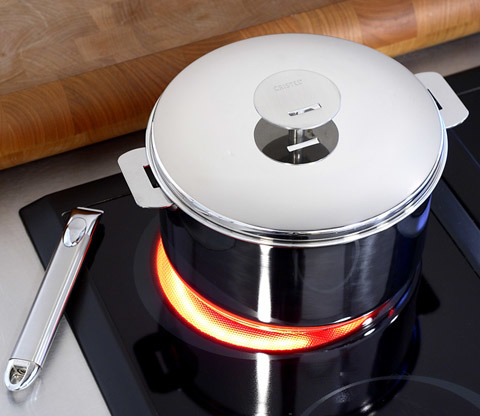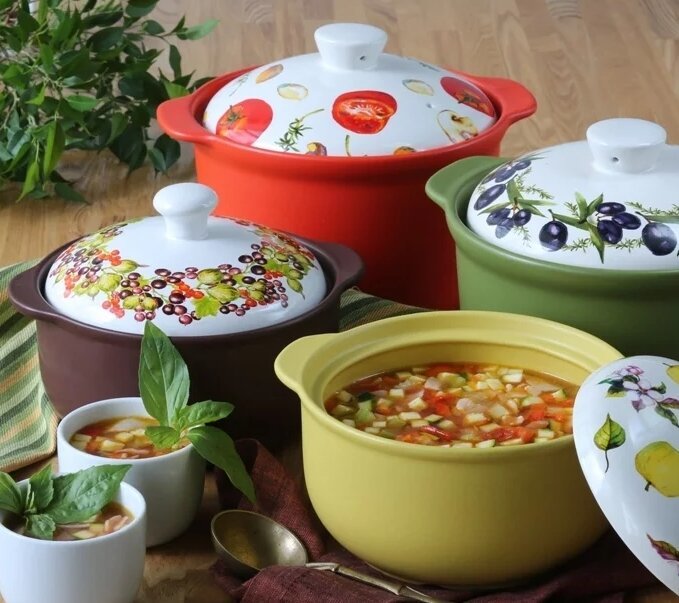Manufacturers constantly produce various devices that can facilitate the difficult work of creating various culinary delights. Not so long ago, another appliance appeared in the kitchen arsenal - an induction panel. Why is it so remarkable?
The most important thing that distinguishes an induction hob from other stove options is the principle of its operation. With a gas stove, everything is very clear: the gas is burning, it heats the dishes, and therefore the food. A conventional electric stove has a heating element, which, under the influence of current, heats up itself and heats food.
The main element in the induction cooker is the induction current. It occurs when a normal current passes through turns of copper wire, which are wound on coils and located under the hob. During the passage of current, an alternating electromagnetic field arises. It then creates this same induction current, under the influence of which the electrons that make up the material begin to move - heating occurs.
The cooking procedure on such a surface is much simpler, faster and more efficient. That's just the dishes have to be changed.
Induction bottom pan: what is it
The content of the article
- Induction bottom pan: what is it
-
Induction Cooker Selection Criteria
- Bottom thickness
- Diameter
-
Types of pots for induction cooker
-
Material classification
- Stainless steel pots
- Cast iron
- Aluminum
- Enamel Pans
-
According to the functional purpose
- Universal pan
- Stewpan
-
Material classification
- Care Rules
The main element of this type of plate is a glass-ceramic surface. Under the influence of an electromagnetic field, the dishes and, therefore, its contents are heated. The surface of the plate does not heat up.
To work on such a hob, special kitchen utensils are required. It should be made of metals that can interact with the magnet. Therefore, using ceramics, glass or non-magnetic metals will not work. If the dish itself does not have magnetic properties, then its bottom should be made of a material that responds to a magnet. Thanks to such tricks of manufacturers, it is quite possible to use products from copper, aluminum and ceramics.
The thickness should not be less than five to ten millimeters, and the diameter - not less than twelve centimeters. This is necessary so that the surface of the dishes completely covers the burner. Furthermore, the bottom of the cookware must be completely even so that there are no gaps between it and the burner. Such thickness prevents the product from deforming and allows it to warm up evenly.
Reference! Whether the product is suitable for such a plate can be easily checked with a magnet. If he stuck to the bottom - such utensils can be safely sent to the induction panel.
Induction Cooker Selection Criteria
Going to the store for new cookware for the induction panel, you must remember that, in addition to magnetic qualities, it must meet two more important parameters: to have a thick bottom and the necessary diameter.
Bottom thickness
To heat up evenly, you should buy dishes that have a special bottom. Its thickness should be at least five millimeters. The thicker it is, the more intense the heating will go. The bottom itself can be made of a homogeneous material or alloy.
The bottom mass makes it possible to make the temperature difference less noticeable when changing the heating mode. The plane of the bottom should be flat and not damaged. The thin bottom is subject to deformation, hissing sounds are possible during operation of the induction cooker. If there is not enough contact with the surface of the stove, then the food will heat up unevenly. In addition, irregularities on the bottom can damage the working part of the plate.
Most manufacturers recommend kitchenware recommended for use on induction panels that is marked “induktion,”as well as an icon depicting a spiral. As a rule, the lower part of such dishes has a special disk, which allows it to be placed perfectly on the surface of the plate and does not allow the bottom to bend. 
Diameter
Any utensils that are supposed to be used on an induction stove must have a special disc that prevents deformation. Do not use dishes if it has a concave bottom.
The minimum diameter of the bottom should not be less than twelve centimeters. Otherwise, there will be no reaction of the magnetic coil and, therefore, there will be no heating.
Reference! For coffee gourmets, special adapters for the Turks in the shape of a circle are on sale. This allows you not to abandon the already familiar little thing. In addition, some models of induction panels are equipped with the Flexinduction function, which allows them to adapt to the size of the dishes installed on them.
Types of pots for induction cooker
On the shelves of shops there is a huge selection of different kitchen utensils. In order to choose the suitable option from all this diversity, it is necessary to delve into some details. All products intended for use on induction cookers can be classified by material, as well as by functional purpose.
Material classification
There is a huge amount of all kinds of utensils compatible with induction panels. For its manufacture use: stainless steel, cast iron, aluminum, copper. As they say, for every taste and color!
Stainless steel pots
Most pots that are made for use on induction panels are made of stainless steel, as it has a high corrosion resistance. Its characteristic features:
- Food does not lose its beneficial qualities.
- Due to the special bottom, cooking time is reduced.
- After cooling, the dishes can be refrigerated with food.
- Utensils from this material are light and durable, have a long service life.
- The design of such a product will fit into any interior.
Dishes made of stainless steel may have an enamel coating. A similar coating is applied to products with thick walls. Noticed: if the surface of the product is not glossy, then the heating process is faster.

Cast iron
This material has long been successfully used for the manufacture of kitchen utensils. He has his own positive qualities:
- the food does not burn and remains warm for a long time;
- this material has a long service life;
- warming up is even;
- cast iron is environmentally friendly.
On products made of this material, a decorative enamel layer is very often applied. The decorative coating may be glossy or matte. On the inside there is often a non-stick coating. If the utensil has a rough texture, then, as a rule, a special enamel is applied to it.
Attention! Dishes made of such a material are rather heavy, therefore special care should be taken in handling so as not to damage the surface of the plate.
Aluminum
Recently, pots made of aluminum, but with special additives, began to appear on sale. Aluminum by itself does not respond to the magnet, but the additives introduced into it make it possible to use such cookware on induction panels. The main thing - do not forget to check whether the inscription "Induction". 
Enamel Pans
Utensils made of iron and coated with enamel are quite suitable for use on induction panels. Various alloys are used to produce such utensils. Key qualities:
- the material is easily heated, environmentally friendly;
- allows you to store cooked food;
- It has a pretty appearance - it is often sold in whole sets, including items of various sizes and purposes.
Use in the oven is possible. The main thing is to prevent sudden temperature jumps and not to cook foods that require temperatures above 250 degrees. 
Important! Before buying, check the product for grooves in the bottom. They can cause amplification of the wave current oscillation, which is unacceptable.
According to the functional purpose
Cookware designed for induction cookers has a wide bottom and low height. The large diameter of the bottom allows you to accelerate heating, and a small height makes it almost instant and uniform. Not only the time required for cooking depends on this, but also the quality of the finished product.
Universal pan
Pots of a universal type will become indispensable for any housewife. They quickly heat up, allow you to cook any soups, side dishes, meat and fish dishes in a short time. You can even boil milk in this utensil.
When buying, you must monitor the following parameters:
- the volume should be in the range from 1.4 to 5.8 liters;
- the bottom should be flat, not thinner than three millimeters and cover at least seventy percent of the surface of the burner.
Often, such utensils are equipped with a disk that prevents deformation - this gives high-quality adhesion to the surface of the plate. Inside the non-stick coating, a substance containing sapphire is added, which protects against scratches. Handles made of bakelite do not heat up, so there is no need for tacks.
Stewpan
Stewpan - one of the types of utensils for the kitchen. It is quite versatile and can perform the functions of both pans and pans. They cook in it, using a lot of water: sauté, stew. It allows you to cook dishes of excellent quality:
- if it is used as a pan, then you can fry steaks of fish or meat or make vegetable frying;
- on a small warm-up you can stew stew, prepare a sauce or pilaf.
The thick bottom allows you to evenly warm the food and does not allow it to burn. Due to this, oil is consumed much less. Stewpan is also used to heat food.
Its advantages:
- fast heating and cooling;
- the presence of a cover;
- multifunctionality;
- high walls - higher than the pan.

Care Rules
Like any other cookware, utensils for induction panels require proper care:
- can be washed in dishwashers;
- it is necessary to wash immediately - it should not be postponed for several days, allowing the drying of the remnants of food;
- Only use mild detergents;
- the use of hard brushes or sponges with an abrasive surface is not allowed;
- Wipe dry after washing to prevent rust.
The resulting coating is removed with vinegar. To combat dark spots, it is enough to boil the utensils in water by adding soda.
The choice of dishes is up to the buyer. It all depends on his needs and preferences. In any case, if you follow simple rules, kitchen utensils will serve for a long time and will not lose their qualities.


